Quantitative Data Analysis Report: Impact of Key Factors on GDP
VerifiedAdded on 2023/06/12
|11
|2626
|406
Report
AI Summary
This report provides a quantitative analysis of the impact of inflation, employment, and unemployment on a country's GDP. It includes a literature review discussing various perspectives on the relationship between these economic indicators and GDP. The analysis uses descriptive statistics, correlation, and regression to assess the relationships. Visualizations, including graphs, illustrate the connections between GDP and each factor. The findings indicate that while GDP is positively correlated with employment and negatively correlated with unemployment, the statistical significance of these relationships is limited based on the regression analysis. The report concludes that GDP is a crucial measure for evaluating economic health, and managing factors like unemployment is essential for fostering economic growth. Desklib offers similar solved assignments for students.
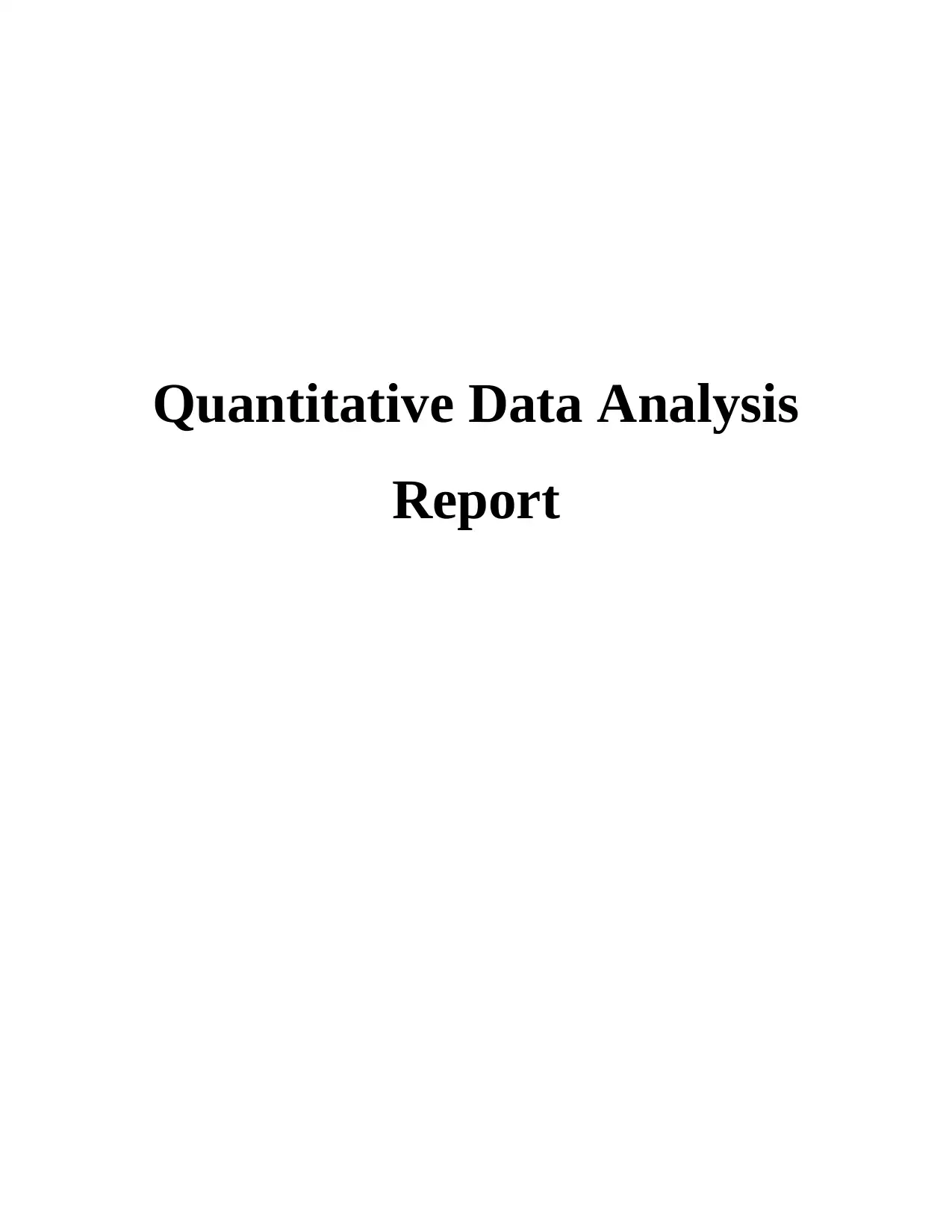
Quantitative Data Analysis
Report
Report
Paraphrase This Document
Need a fresh take? Get an instant paraphrase of this document with our AI Paraphraser
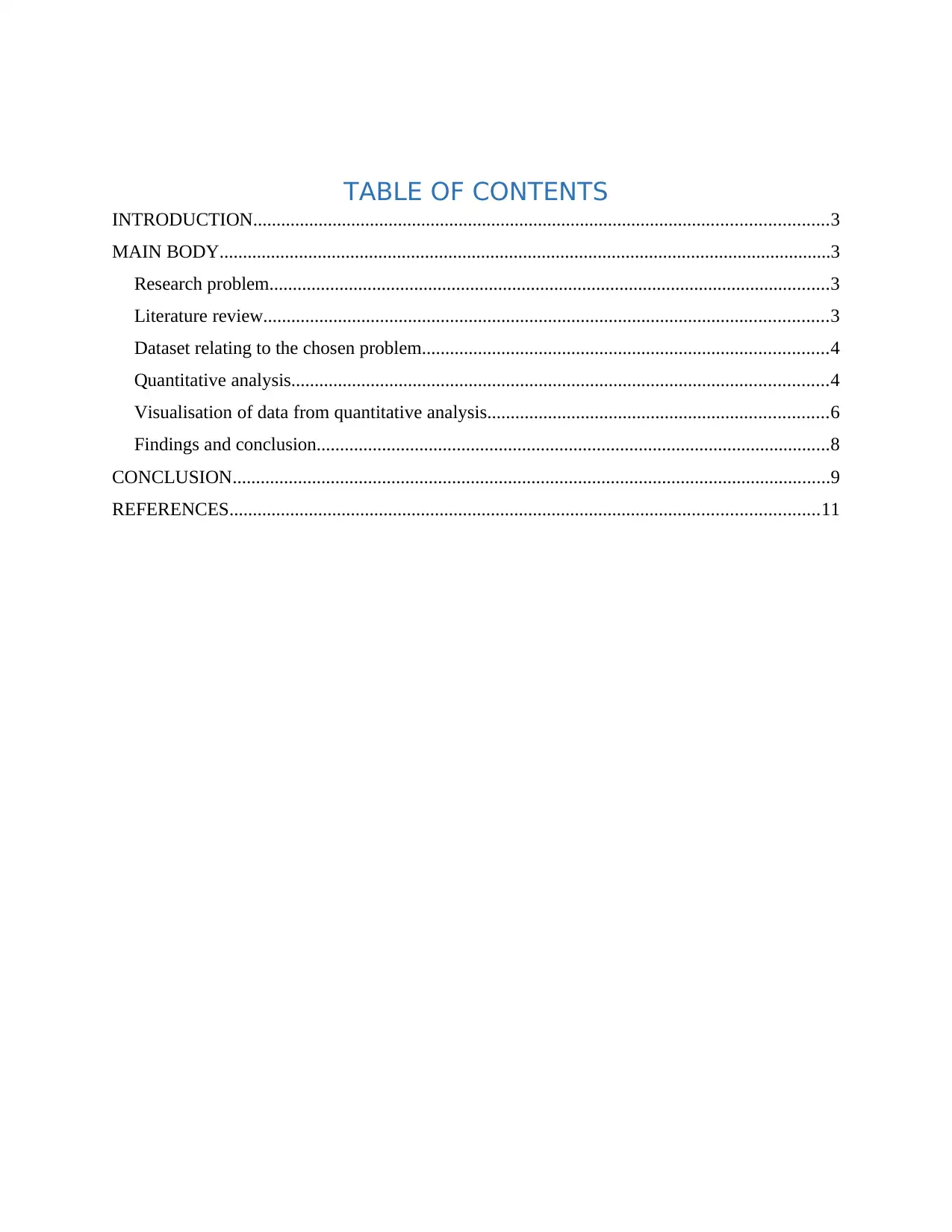
TABLE OF CONTENTS
INTRODUCTION...........................................................................................................................3
MAIN BODY...................................................................................................................................3
Research problem........................................................................................................................3
Literature review.........................................................................................................................3
Dataset relating to the chosen problem.......................................................................................4
Quantitative analysis...................................................................................................................4
Visualisation of data from quantitative analysis.........................................................................6
Findings and conclusion..............................................................................................................8
CONCLUSION................................................................................................................................9
REFERENCES..............................................................................................................................11
INTRODUCTION...........................................................................................................................3
MAIN BODY...................................................................................................................................3
Research problem........................................................................................................................3
Literature review.........................................................................................................................3
Dataset relating to the chosen problem.......................................................................................4
Quantitative analysis...................................................................................................................4
Visualisation of data from quantitative analysis.........................................................................6
Findings and conclusion..............................................................................................................8
CONCLUSION................................................................................................................................9
REFERENCES..............................................................................................................................11
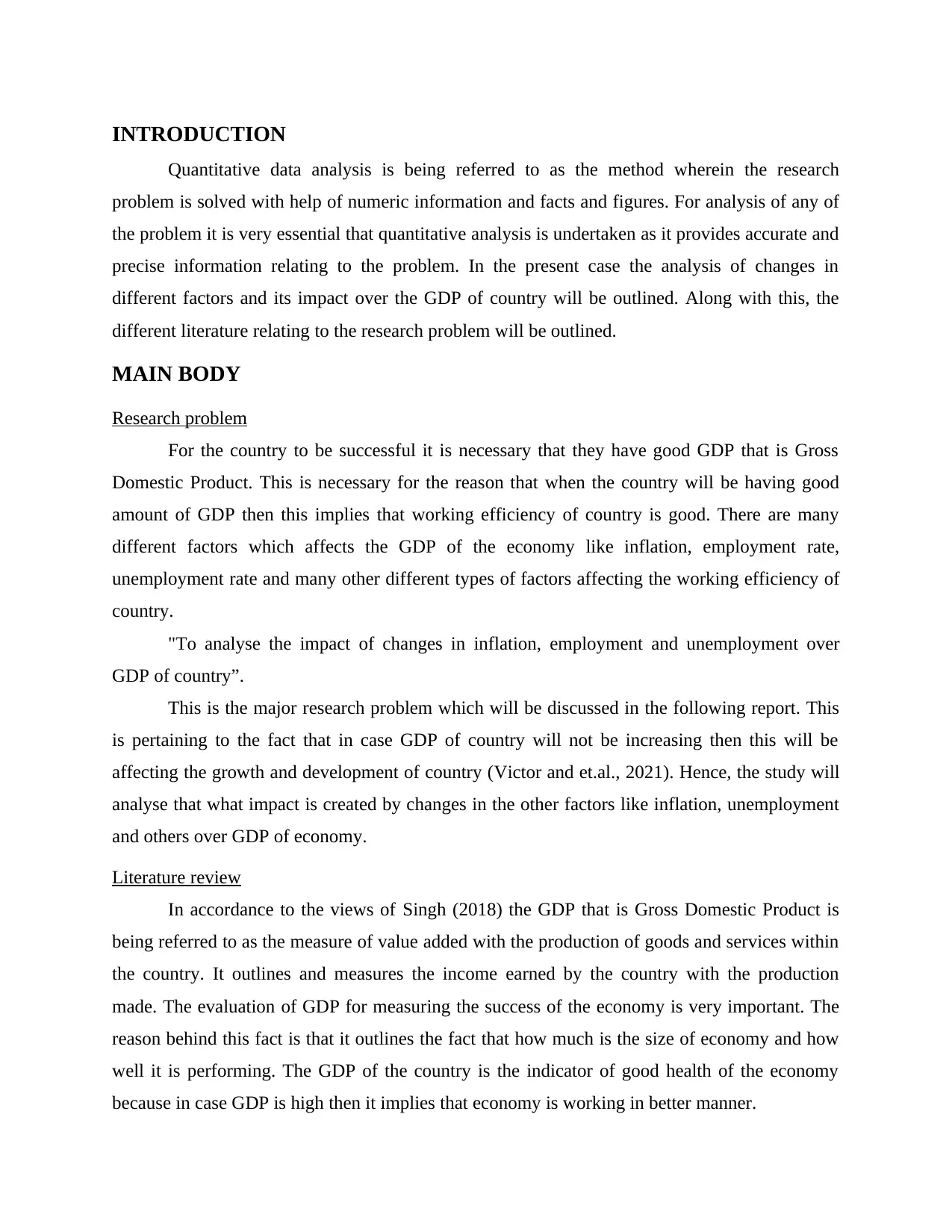
INTRODUCTION
Quantitative data analysis is being referred to as the method wherein the research
problem is solved with help of numeric information and facts and figures. For analysis of any of
the problem it is very essential that quantitative analysis is undertaken as it provides accurate and
precise information relating to the problem. In the present case the analysis of changes in
different factors and its impact over the GDP of country will be outlined. Along with this, the
different literature relating to the research problem will be outlined.
MAIN BODY
Research problem
For the country to be successful it is necessary that they have good GDP that is Gross
Domestic Product. This is necessary for the reason that when the country will be having good
amount of GDP then this implies that working efficiency of country is good. There are many
different factors which affects the GDP of the economy like inflation, employment rate,
unemployment rate and many other different types of factors affecting the working efficiency of
country.
"To analyse the impact of changes in inflation, employment and unemployment over
GDP of country”.
This is the major research problem which will be discussed in the following report. This
is pertaining to the fact that in case GDP of country will not be increasing then this will be
affecting the growth and development of country (Victor and et.al., 2021). Hence, the study will
analyse that what impact is created by changes in the other factors like inflation, unemployment
and others over GDP of economy.
Literature review
In accordance to the views of Singh (2018) the GDP that is Gross Domestic Product is
being referred to as the measure of value added with the production of goods and services within
the country. It outlines and measures the income earned by the country with the production
made. The evaluation of GDP for measuring the success of the economy is very important. The
reason behind this fact is that it outlines the fact that how much is the size of economy and how
well it is performing. The GDP of the country is the indicator of good health of the economy
because in case GDP is high then it implies that economy is working in better manner.
Quantitative data analysis is being referred to as the method wherein the research
problem is solved with help of numeric information and facts and figures. For analysis of any of
the problem it is very essential that quantitative analysis is undertaken as it provides accurate and
precise information relating to the problem. In the present case the analysis of changes in
different factors and its impact over the GDP of country will be outlined. Along with this, the
different literature relating to the research problem will be outlined.
MAIN BODY
Research problem
For the country to be successful it is necessary that they have good GDP that is Gross
Domestic Product. This is necessary for the reason that when the country will be having good
amount of GDP then this implies that working efficiency of country is good. There are many
different factors which affects the GDP of the economy like inflation, employment rate,
unemployment rate and many other different types of factors affecting the working efficiency of
country.
"To analyse the impact of changes in inflation, employment and unemployment over
GDP of country”.
This is the major research problem which will be discussed in the following report. This
is pertaining to the fact that in case GDP of country will not be increasing then this will be
affecting the growth and development of country (Victor and et.al., 2021). Hence, the study will
analyse that what impact is created by changes in the other factors like inflation, unemployment
and others over GDP of economy.
Literature review
In accordance to the views of Singh (2018) the GDP that is Gross Domestic Product is
being referred to as the measure of value added with the production of goods and services within
the country. It outlines and measures the income earned by the country with the production
made. The evaluation of GDP for measuring the success of the economy is very important. The
reason behind this fact is that it outlines the fact that how much is the size of economy and how
well it is performing. The GDP of the country is the indicator of good health of the economy
because in case GDP is high then it implies that economy is working in better manner.
⊘ This is a preview!⊘
Do you want full access?
Subscribe today to unlock all pages.

Trusted by 1+ million students worldwide
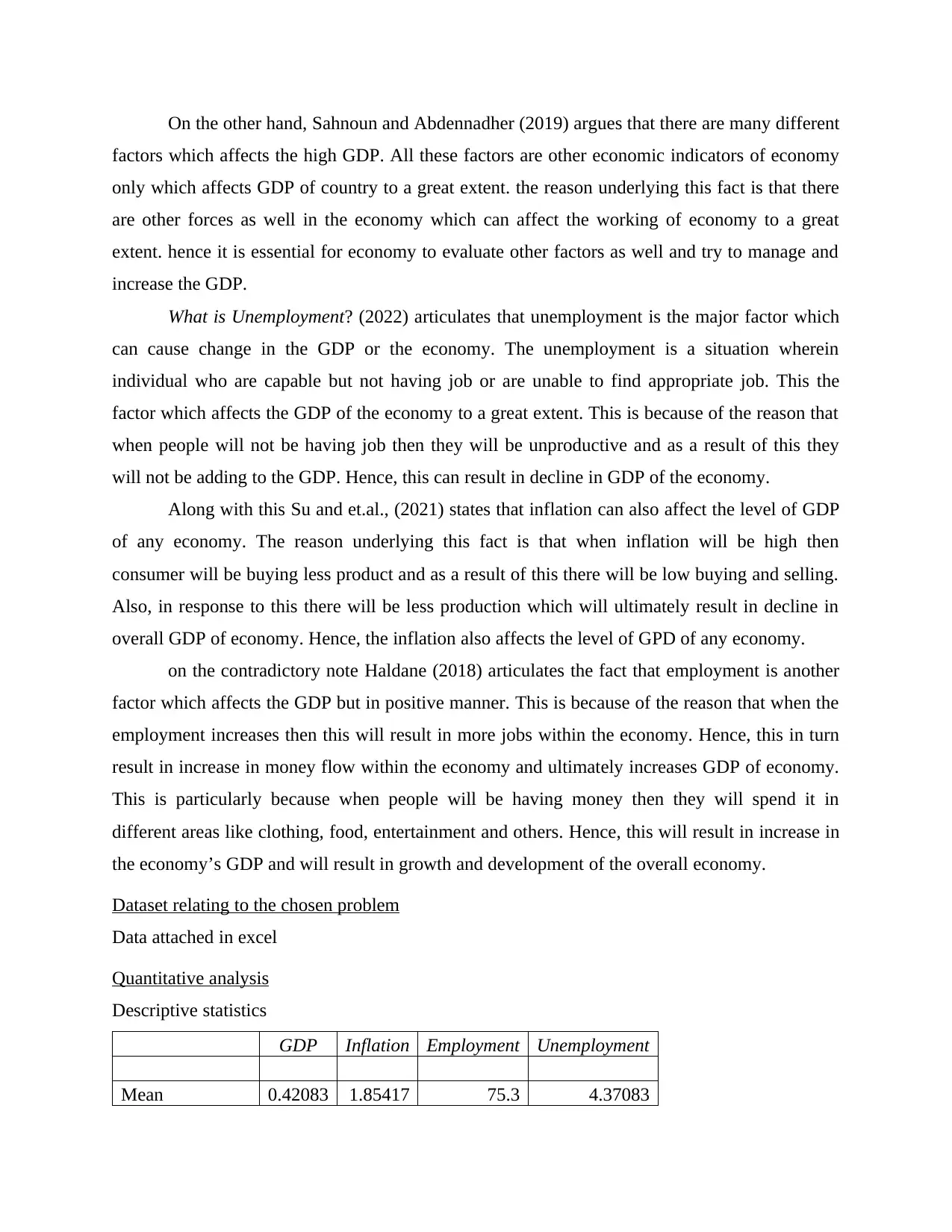
On the other hand, Sahnoun and Abdennadher (2019) argues that there are many different
factors which affects the high GDP. All these factors are other economic indicators of economy
only which affects GDP of country to a great extent. the reason underlying this fact is that there
are other forces as well in the economy which can affect the working of economy to a great
extent. hence it is essential for economy to evaluate other factors as well and try to manage and
increase the GDP.
What is Unemployment? (2022) articulates that unemployment is the major factor which
can cause change in the GDP or the economy. The unemployment is a situation wherein
individual who are capable but not having job or are unable to find appropriate job. This the
factor which affects the GDP of the economy to a great extent. This is because of the reason that
when people will not be having job then they will be unproductive and as a result of this they
will not be adding to the GDP. Hence, this can result in decline in GDP of the economy.
Along with this Su and et.al., (2021) states that inflation can also affect the level of GDP
of any economy. The reason underlying this fact is that when inflation will be high then
consumer will be buying less product and as a result of this there will be low buying and selling.
Also, in response to this there will be less production which will ultimately result in decline in
overall GDP of economy. Hence, the inflation also affects the level of GPD of any economy.
on the contradictory note Haldane (2018) articulates the fact that employment is another
factor which affects the GDP but in positive manner. This is because of the reason that when the
employment increases then this will result in more jobs within the economy. Hence, this in turn
result in increase in money flow within the economy and ultimately increases GDP of economy.
This is particularly because when people will be having money then they will spend it in
different areas like clothing, food, entertainment and others. Hence, this will result in increase in
the economy’s GDP and will result in growth and development of the overall economy.
Dataset relating to the chosen problem
Data attached in excel
Quantitative analysis
Descriptive statistics
GDP Inflation Employment Unemployment
Mean 0.42083 1.85417 75.3 4.37083
factors which affects the high GDP. All these factors are other economic indicators of economy
only which affects GDP of country to a great extent. the reason underlying this fact is that there
are other forces as well in the economy which can affect the working of economy to a great
extent. hence it is essential for economy to evaluate other factors as well and try to manage and
increase the GDP.
What is Unemployment? (2022) articulates that unemployment is the major factor which
can cause change in the GDP or the economy. The unemployment is a situation wherein
individual who are capable but not having job or are unable to find appropriate job. This the
factor which affects the GDP of the economy to a great extent. This is because of the reason that
when people will not be having job then they will be unproductive and as a result of this they
will not be adding to the GDP. Hence, this can result in decline in GDP of the economy.
Along with this Su and et.al., (2021) states that inflation can also affect the level of GDP
of any economy. The reason underlying this fact is that when inflation will be high then
consumer will be buying less product and as a result of this there will be low buying and selling.
Also, in response to this there will be less production which will ultimately result in decline in
overall GDP of economy. Hence, the inflation also affects the level of GPD of any economy.
on the contradictory note Haldane (2018) articulates the fact that employment is another
factor which affects the GDP but in positive manner. This is because of the reason that when the
employment increases then this will result in more jobs within the economy. Hence, this in turn
result in increase in money flow within the economy and ultimately increases GDP of economy.
This is particularly because when people will be having money then they will spend it in
different areas like clothing, food, entertainment and others. Hence, this will result in increase in
the economy’s GDP and will result in growth and development of the overall economy.
Dataset relating to the chosen problem
Data attached in excel
Quantitative analysis
Descriptive statistics
GDP Inflation Employment Unemployment
Mean 0.42083 1.85417 75.3 4.37083
Paraphrase This Document
Need a fresh take? Get an instant paraphrase of this document with our AI Paraphraser
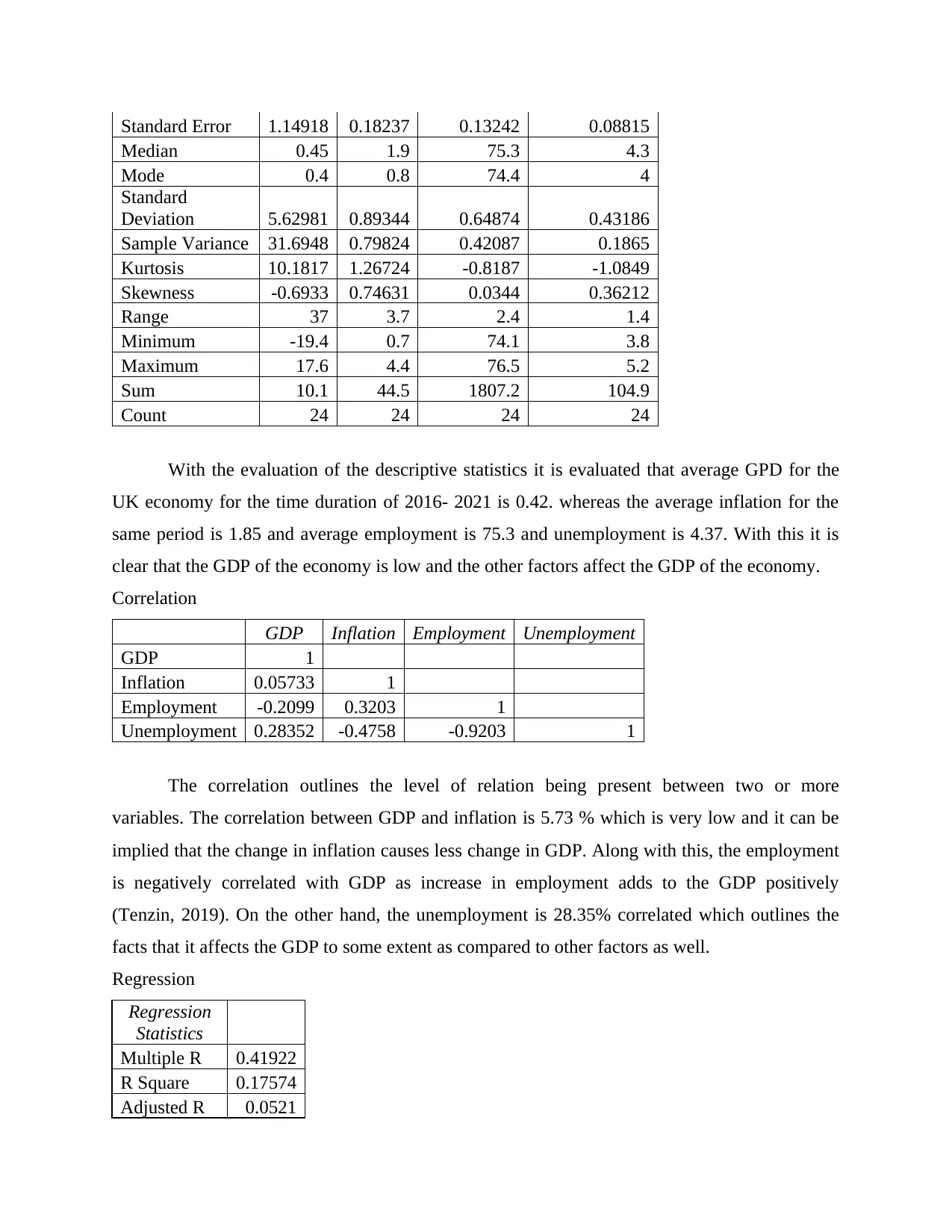
Standard Error 1.14918 0.18237 0.13242 0.08815
Median 0.45 1.9 75.3 4.3
Mode 0.4 0.8 74.4 4
Standard
Deviation 5.62981 0.89344 0.64874 0.43186
Sample Variance 31.6948 0.79824 0.42087 0.1865
Kurtosis 10.1817 1.26724 -0.8187 -1.0849
Skewness -0.6933 0.74631 0.0344 0.36212
Range 37 3.7 2.4 1.4
Minimum -19.4 0.7 74.1 3.8
Maximum 17.6 4.4 76.5 5.2
Sum 10.1 44.5 1807.2 104.9
Count 24 24 24 24
With the evaluation of the descriptive statistics it is evaluated that average GPD for the
UK economy for the time duration of 2016- 2021 is 0.42. whereas the average inflation for the
same period is 1.85 and average employment is 75.3 and unemployment is 4.37. With this it is
clear that the GDP of the economy is low and the other factors affect the GDP of the economy.
Correlation
GDP Inflation Employment Unemployment
GDP 1
Inflation 0.05733 1
Employment -0.2099 0.3203 1
Unemployment 0.28352 -0.4758 -0.9203 1
The correlation outlines the level of relation being present between two or more
variables. The correlation between GDP and inflation is 5.73 % which is very low and it can be
implied that the change in inflation causes less change in GDP. Along with this, the employment
is negatively correlated with GDP as increase in employment adds to the GDP positively
(Tenzin, 2019). On the other hand, the unemployment is 28.35% correlated which outlines the
facts that it affects the GDP to some extent as compared to other factors as well.
Regression
Regression
Statistics
Multiple R 0.41922
R Square 0.17574
Adjusted R 0.0521
Median 0.45 1.9 75.3 4.3
Mode 0.4 0.8 74.4 4
Standard
Deviation 5.62981 0.89344 0.64874 0.43186
Sample Variance 31.6948 0.79824 0.42087 0.1865
Kurtosis 10.1817 1.26724 -0.8187 -1.0849
Skewness -0.6933 0.74631 0.0344 0.36212
Range 37 3.7 2.4 1.4
Minimum -19.4 0.7 74.1 3.8
Maximum 17.6 4.4 76.5 5.2
Sum 10.1 44.5 1807.2 104.9
Count 24 24 24 24
With the evaluation of the descriptive statistics it is evaluated that average GPD for the
UK economy for the time duration of 2016- 2021 is 0.42. whereas the average inflation for the
same period is 1.85 and average employment is 75.3 and unemployment is 4.37. With this it is
clear that the GDP of the economy is low and the other factors affect the GDP of the economy.
Correlation
GDP Inflation Employment Unemployment
GDP 1
Inflation 0.05733 1
Employment -0.2099 0.3203 1
Unemployment 0.28352 -0.4758 -0.9203 1
The correlation outlines the level of relation being present between two or more
variables. The correlation between GDP and inflation is 5.73 % which is very low and it can be
implied that the change in inflation causes less change in GDP. Along with this, the employment
is negatively correlated with GDP as increase in employment adds to the GDP positively
(Tenzin, 2019). On the other hand, the unemployment is 28.35% correlated which outlines the
facts that it affects the GDP to some extent as compared to other factors as well.
Regression
Regression
Statistics
Multiple R 0.41922
R Square 0.17574
Adjusted R 0.0521
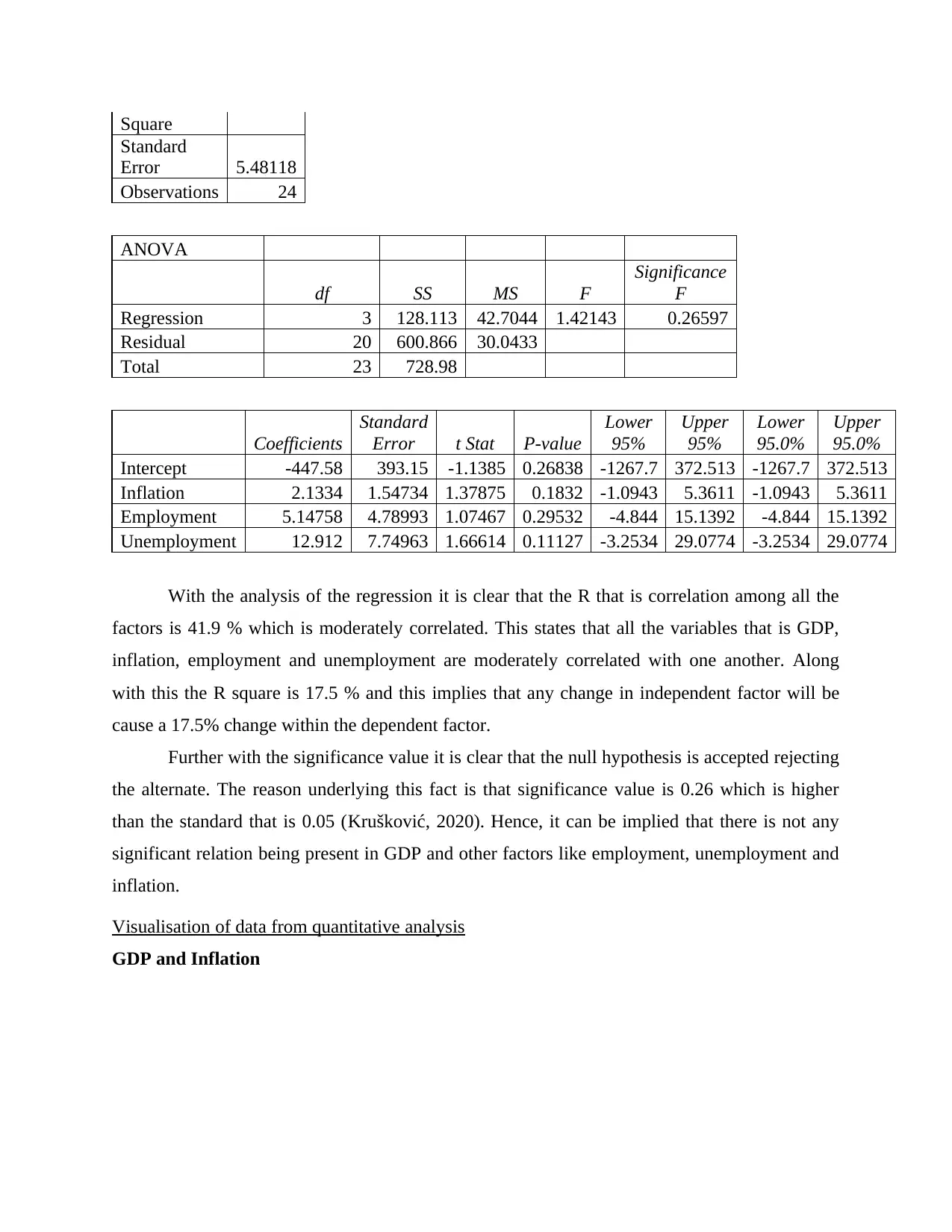
Square
Standard
Error 5.48118
Observations 24
ANOVA
df SS MS F
Significance
F
Regression 3 128.113 42.7044 1.42143 0.26597
Residual 20 600.866 30.0433
Total 23 728.98
Coefficients
Standard
Error t Stat P-value
Lower
95%
Upper
95%
Lower
95.0%
Upper
95.0%
Intercept -447.58 393.15 -1.1385 0.26838 -1267.7 372.513 -1267.7 372.513
Inflation 2.1334 1.54734 1.37875 0.1832 -1.0943 5.3611 -1.0943 5.3611
Employment 5.14758 4.78993 1.07467 0.29532 -4.844 15.1392 -4.844 15.1392
Unemployment 12.912 7.74963 1.66614 0.11127 -3.2534 29.0774 -3.2534 29.0774
With the analysis of the regression it is clear that the R that is correlation among all the
factors is 41.9 % which is moderately correlated. This states that all the variables that is GDP,
inflation, employment and unemployment are moderately correlated with one another. Along
with this the R square is 17.5 % and this implies that any change in independent factor will be
cause a 17.5% change within the dependent factor.
Further with the significance value it is clear that the null hypothesis is accepted rejecting
the alternate. The reason underlying this fact is that significance value is 0.26 which is higher
than the standard that is 0.05 (Krušković, 2020). Hence, it can be implied that there is not any
significant relation being present in GDP and other factors like employment, unemployment and
inflation.
Visualisation of data from quantitative analysis
GDP and Inflation
Standard
Error 5.48118
Observations 24
ANOVA
df SS MS F
Significance
F
Regression 3 128.113 42.7044 1.42143 0.26597
Residual 20 600.866 30.0433
Total 23 728.98
Coefficients
Standard
Error t Stat P-value
Lower
95%
Upper
95%
Lower
95.0%
Upper
95.0%
Intercept -447.58 393.15 -1.1385 0.26838 -1267.7 372.513 -1267.7 372.513
Inflation 2.1334 1.54734 1.37875 0.1832 -1.0943 5.3611 -1.0943 5.3611
Employment 5.14758 4.78993 1.07467 0.29532 -4.844 15.1392 -4.844 15.1392
Unemployment 12.912 7.74963 1.66614 0.11127 -3.2534 29.0774 -3.2534 29.0774
With the analysis of the regression it is clear that the R that is correlation among all the
factors is 41.9 % which is moderately correlated. This states that all the variables that is GDP,
inflation, employment and unemployment are moderately correlated with one another. Along
with this the R square is 17.5 % and this implies that any change in independent factor will be
cause a 17.5% change within the dependent factor.
Further with the significance value it is clear that the null hypothesis is accepted rejecting
the alternate. The reason underlying this fact is that significance value is 0.26 which is higher
than the standard that is 0.05 (Krušković, 2020). Hence, it can be implied that there is not any
significant relation being present in GDP and other factors like employment, unemployment and
inflation.
Visualisation of data from quantitative analysis
GDP and Inflation
⊘ This is a preview!⊘
Do you want full access?
Subscribe today to unlock all pages.

Trusted by 1+ million students worldwide
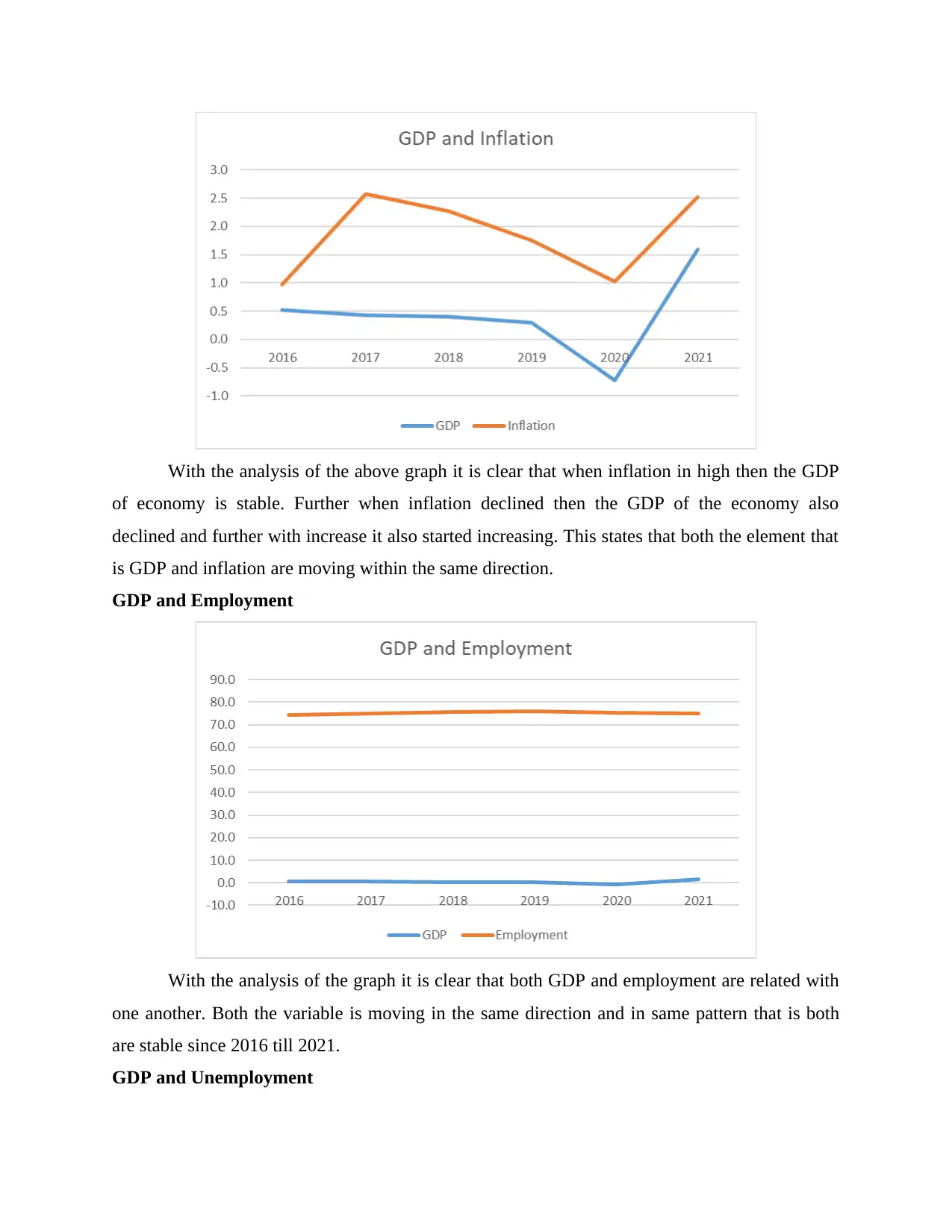
With the analysis of the above graph it is clear that when inflation in high then the GDP
of economy is stable. Further when inflation declined then the GDP of the economy also
declined and further with increase it also started increasing. This states that both the element that
is GDP and inflation are moving within the same direction.
GDP and Employment
With the analysis of the graph it is clear that both GDP and employment are related with
one another. Both the variable is moving in the same direction and in same pattern that is both
are stable since 2016 till 2021.
GDP and Unemployment
of economy is stable. Further when inflation declined then the GDP of the economy also
declined and further with increase it also started increasing. This states that both the element that
is GDP and inflation are moving within the same direction.
GDP and Employment
With the analysis of the graph it is clear that both GDP and employment are related with
one another. Both the variable is moving in the same direction and in same pattern that is both
are stable since 2016 till 2021.
GDP and Unemployment
Paraphrase This Document
Need a fresh take? Get an instant paraphrase of this document with our AI Paraphraser
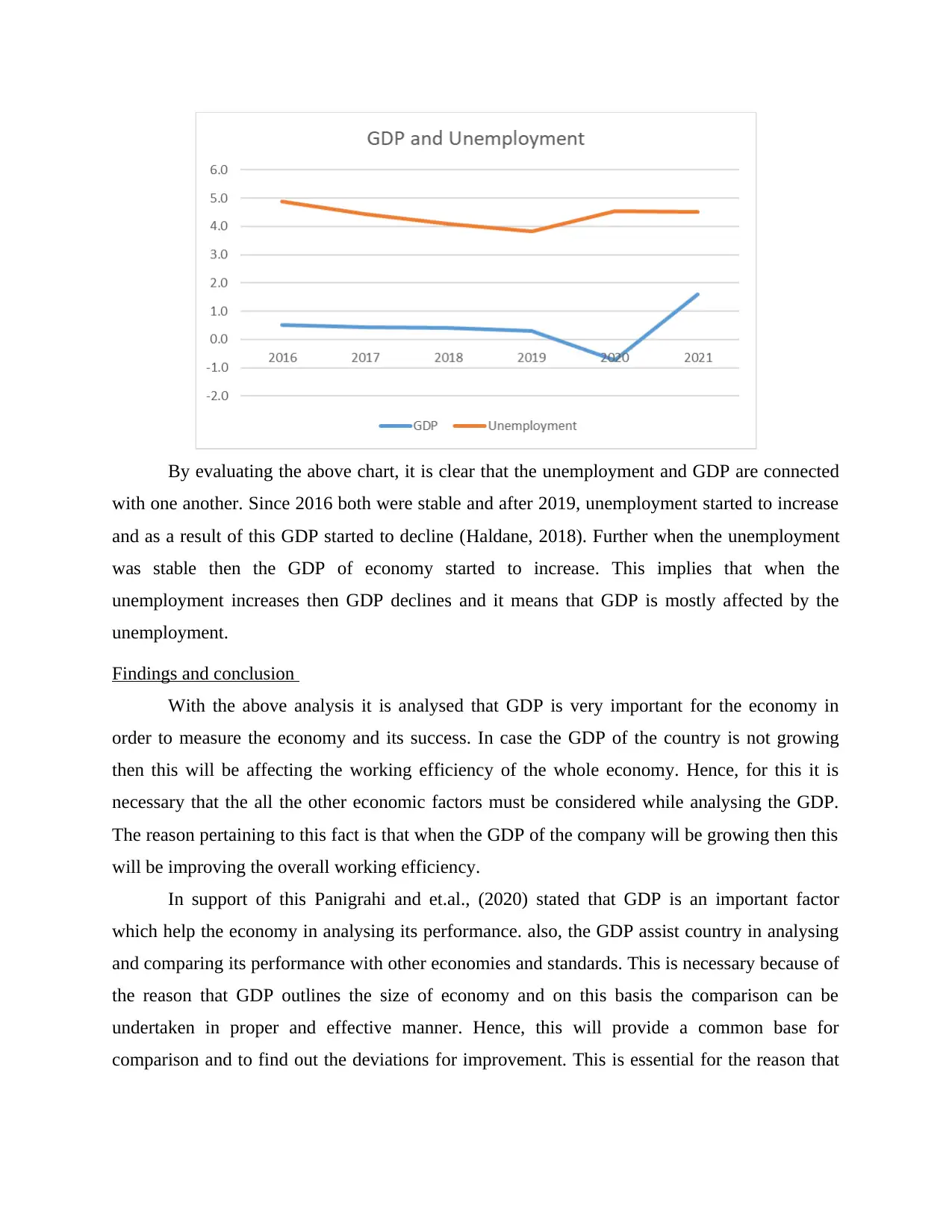
By evaluating the above chart, it is clear that the unemployment and GDP are connected
with one another. Since 2016 both were stable and after 2019, unemployment started to increase
and as a result of this GDP started to decline (Haldane, 2018). Further when the unemployment
was stable then the GDP of economy started to increase. This implies that when the
unemployment increases then GDP declines and it means that GDP is mostly affected by the
unemployment.
Findings and conclusion
With the above analysis it is analysed that GDP is very important for the economy in
order to measure the economy and its success. In case the GDP of the country is not growing
then this will be affecting the working efficiency of the whole economy. Hence, for this it is
necessary that the all the other economic factors must be considered while analysing the GDP.
The reason pertaining to this fact is that when the GDP of the company will be growing then this
will be improving the overall working efficiency.
In support of this Panigrahi and et.al., (2020) stated that GDP is an important factor
which help the economy in analysing its performance. also, the GDP assist country in analysing
and comparing its performance with other economies and standards. This is necessary because of
the reason that GDP outlines the size of economy and on this basis the comparison can be
undertaken in proper and effective manner. Hence, this will provide a common base for
comparison and to find out the deviations for improvement. This is essential for the reason that
with one another. Since 2016 both were stable and after 2019, unemployment started to increase
and as a result of this GDP started to decline (Haldane, 2018). Further when the unemployment
was stable then the GDP of economy started to increase. This implies that when the
unemployment increases then GDP declines and it means that GDP is mostly affected by the
unemployment.
Findings and conclusion
With the above analysis it is analysed that GDP is very important for the economy in
order to measure the economy and its success. In case the GDP of the country is not growing
then this will be affecting the working efficiency of the whole economy. Hence, for this it is
necessary that the all the other economic factors must be considered while analysing the GDP.
The reason pertaining to this fact is that when the GDP of the company will be growing then this
will be improving the overall working efficiency.
In support of this Panigrahi and et.al., (2020) stated that GDP is an important factor
which help the economy in analysing its performance. also, the GDP assist country in analysing
and comparing its performance with other economies and standards. This is necessary because of
the reason that GDP outlines the size of economy and on this basis the comparison can be
undertaken in proper and effective manner. Hence, this will provide a common base for
comparison and to find out the deviations for improvement. This is essential for the reason that
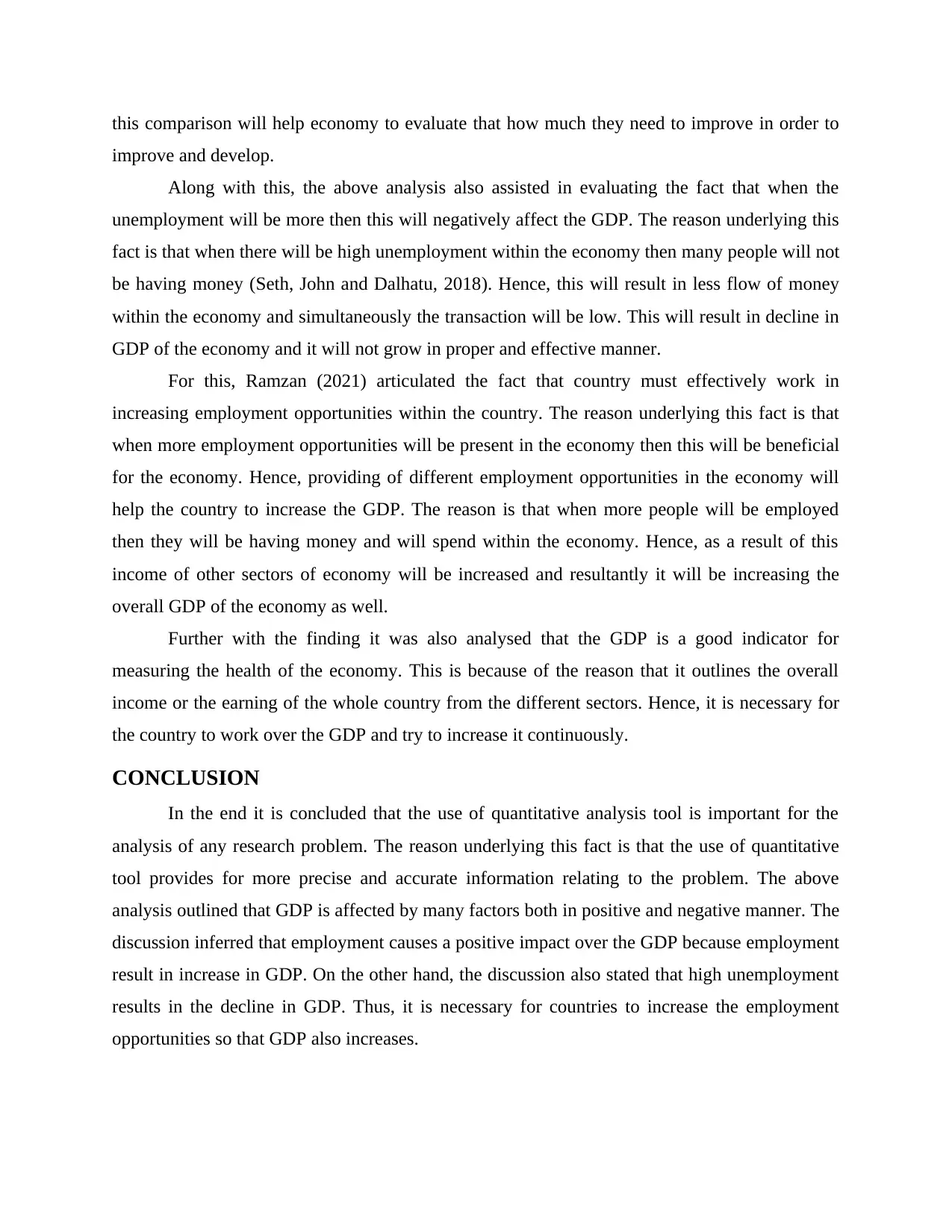
this comparison will help economy to evaluate that how much they need to improve in order to
improve and develop.
Along with this, the above analysis also assisted in evaluating the fact that when the
unemployment will be more then this will negatively affect the GDP. The reason underlying this
fact is that when there will be high unemployment within the economy then many people will not
be having money (Seth, John and Dalhatu, 2018). Hence, this will result in less flow of money
within the economy and simultaneously the transaction will be low. This will result in decline in
GDP of the economy and it will not grow in proper and effective manner.
For this, Ramzan (2021) articulated the fact that country must effectively work in
increasing employment opportunities within the country. The reason underlying this fact is that
when more employment opportunities will be present in the economy then this will be beneficial
for the economy. Hence, providing of different employment opportunities in the economy will
help the country to increase the GDP. The reason is that when more people will be employed
then they will be having money and will spend within the economy. Hence, as a result of this
income of other sectors of economy will be increased and resultantly it will be increasing the
overall GDP of the economy as well.
Further with the finding it was also analysed that the GDP is a good indicator for
measuring the health of the economy. This is because of the reason that it outlines the overall
income or the earning of the whole country from the different sectors. Hence, it is necessary for
the country to work over the GDP and try to increase it continuously.
CONCLUSION
In the end it is concluded that the use of quantitative analysis tool is important for the
analysis of any research problem. The reason underlying this fact is that the use of quantitative
tool provides for more precise and accurate information relating to the problem. The above
analysis outlined that GDP is affected by many factors both in positive and negative manner. The
discussion inferred that employment causes a positive impact over the GDP because employment
result in increase in GDP. On the other hand, the discussion also stated that high unemployment
results in the decline in GDP. Thus, it is necessary for countries to increase the employment
opportunities so that GDP also increases.
improve and develop.
Along with this, the above analysis also assisted in evaluating the fact that when the
unemployment will be more then this will negatively affect the GDP. The reason underlying this
fact is that when there will be high unemployment within the economy then many people will not
be having money (Seth, John and Dalhatu, 2018). Hence, this will result in less flow of money
within the economy and simultaneously the transaction will be low. This will result in decline in
GDP of the economy and it will not grow in proper and effective manner.
For this, Ramzan (2021) articulated the fact that country must effectively work in
increasing employment opportunities within the country. The reason underlying this fact is that
when more employment opportunities will be present in the economy then this will be beneficial
for the economy. Hence, providing of different employment opportunities in the economy will
help the country to increase the GDP. The reason is that when more people will be employed
then they will be having money and will spend within the economy. Hence, as a result of this
income of other sectors of economy will be increased and resultantly it will be increasing the
overall GDP of the economy as well.
Further with the finding it was also analysed that the GDP is a good indicator for
measuring the health of the economy. This is because of the reason that it outlines the overall
income or the earning of the whole country from the different sectors. Hence, it is necessary for
the country to work over the GDP and try to increase it continuously.
CONCLUSION
In the end it is concluded that the use of quantitative analysis tool is important for the
analysis of any research problem. The reason underlying this fact is that the use of quantitative
tool provides for more precise and accurate information relating to the problem. The above
analysis outlined that GDP is affected by many factors both in positive and negative manner. The
discussion inferred that employment causes a positive impact over the GDP because employment
result in increase in GDP. On the other hand, the discussion also stated that high unemployment
results in the decline in GDP. Thus, it is necessary for countries to increase the employment
opportunities so that GDP also increases.
⊘ This is a preview!⊘
Do you want full access?
Subscribe today to unlock all pages.

Trusted by 1+ million students worldwide

Paraphrase This Document
Need a fresh take? Get an instant paraphrase of this document with our AI Paraphraser
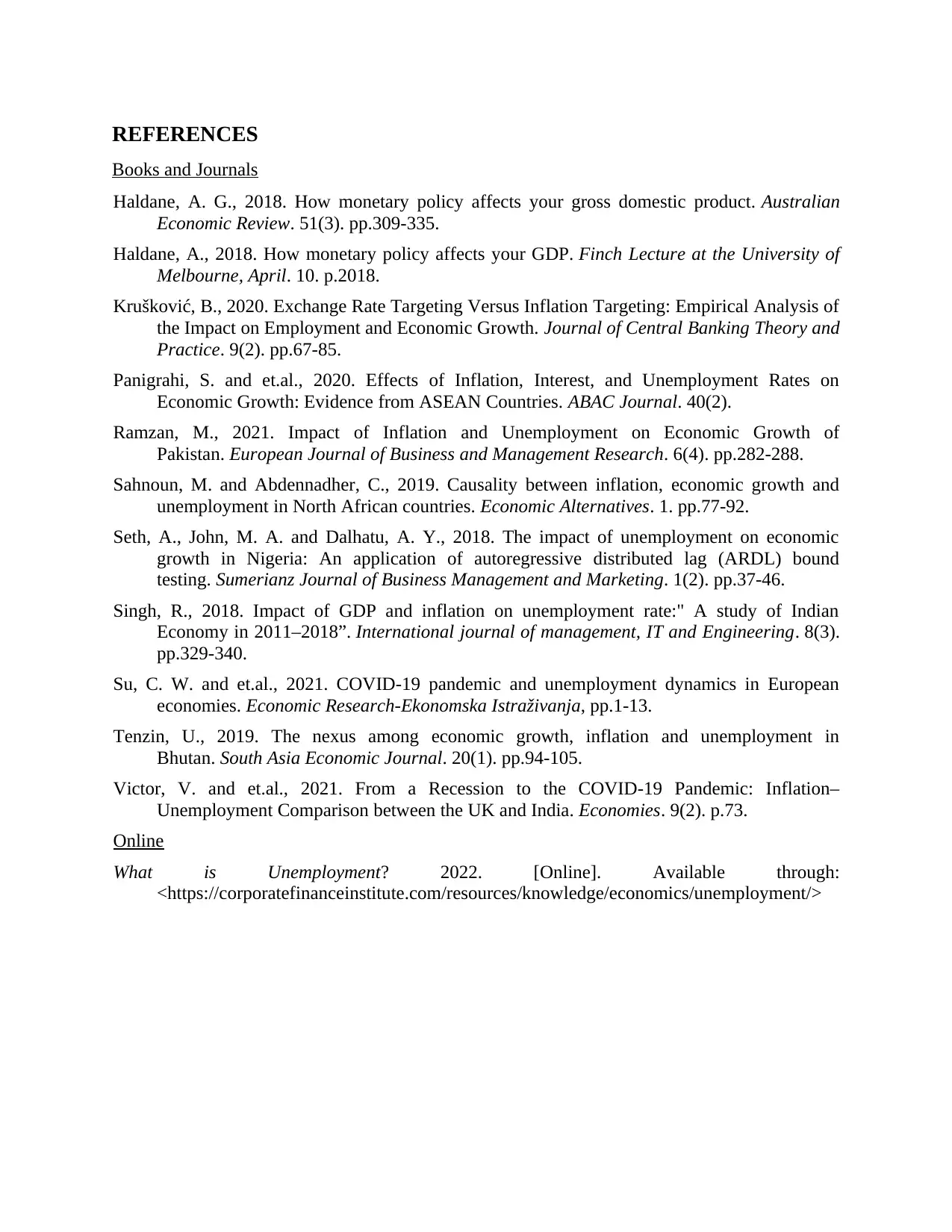
REFERENCES
Books and Journals
Haldane, A. G., 2018. How monetary policy affects your gross domestic product. Australian
Economic Review. 51(3). pp.309-335.
Haldane, A., 2018. How monetary policy affects your GDP. Finch Lecture at the University of
Melbourne, April. 10. p.2018.
Krušković, B., 2020. Exchange Rate Targeting Versus Inflation Targeting: Empirical Analysis of
the Impact on Employment and Economic Growth. Journal of Central Banking Theory and
Practice. 9(2). pp.67-85.
Panigrahi, S. and et.al., 2020. Effects of Inflation, Interest, and Unemployment Rates on
Economic Growth: Evidence from ASEAN Countries. ABAC Journal. 40(2).
Ramzan, M., 2021. Impact of Inflation and Unemployment on Economic Growth of
Pakistan. European Journal of Business and Management Research. 6(4). pp.282-288.
Sahnoun, M. and Abdennadher, C., 2019. Causality between inflation, economic growth and
unemployment in North African countries. Economic Alternatives. 1. pp.77-92.
Seth, A., John, M. A. and Dalhatu, A. Y., 2018. The impact of unemployment on economic
growth in Nigeria: An application of autoregressive distributed lag (ARDL) bound
testing. Sumerianz Journal of Business Management and Marketing. 1(2). pp.37-46.
Singh, R., 2018. Impact of GDP and inflation on unemployment rate:" A study of Indian
Economy in 2011–2018”. International journal of management, IT and Engineering. 8(3).
pp.329-340.
Su, C. W. and et.al., 2021. COVID-19 pandemic and unemployment dynamics in European
economies. Economic Research-Ekonomska Istraživanja, pp.1-13.
Tenzin, U., 2019. The nexus among economic growth, inflation and unemployment in
Bhutan. South Asia Economic Journal. 20(1). pp.94-105.
Victor, V. and et.al., 2021. From a Recession to the COVID-19 Pandemic: Inflation–
Unemployment Comparison between the UK and India. Economies. 9(2). p.73.
Online
What is Unemployment? 2022. [Online]. Available through:
<https://corporatefinanceinstitute.com/resources/knowledge/economics/unemployment/>
Books and Journals
Haldane, A. G., 2018. How monetary policy affects your gross domestic product. Australian
Economic Review. 51(3). pp.309-335.
Haldane, A., 2018. How monetary policy affects your GDP. Finch Lecture at the University of
Melbourne, April. 10. p.2018.
Krušković, B., 2020. Exchange Rate Targeting Versus Inflation Targeting: Empirical Analysis of
the Impact on Employment and Economic Growth. Journal of Central Banking Theory and
Practice. 9(2). pp.67-85.
Panigrahi, S. and et.al., 2020. Effects of Inflation, Interest, and Unemployment Rates on
Economic Growth: Evidence from ASEAN Countries. ABAC Journal. 40(2).
Ramzan, M., 2021. Impact of Inflation and Unemployment on Economic Growth of
Pakistan. European Journal of Business and Management Research. 6(4). pp.282-288.
Sahnoun, M. and Abdennadher, C., 2019. Causality between inflation, economic growth and
unemployment in North African countries. Economic Alternatives. 1. pp.77-92.
Seth, A., John, M. A. and Dalhatu, A. Y., 2018. The impact of unemployment on economic
growth in Nigeria: An application of autoregressive distributed lag (ARDL) bound
testing. Sumerianz Journal of Business Management and Marketing. 1(2). pp.37-46.
Singh, R., 2018. Impact of GDP and inflation on unemployment rate:" A study of Indian
Economy in 2011–2018”. International journal of management, IT and Engineering. 8(3).
pp.329-340.
Su, C. W. and et.al., 2021. COVID-19 pandemic and unemployment dynamics in European
economies. Economic Research-Ekonomska Istraživanja, pp.1-13.
Tenzin, U., 2019. The nexus among economic growth, inflation and unemployment in
Bhutan. South Asia Economic Journal. 20(1). pp.94-105.
Victor, V. and et.al., 2021. From a Recession to the COVID-19 Pandemic: Inflation–
Unemployment Comparison between the UK and India. Economies. 9(2). p.73.
Online
What is Unemployment? 2022. [Online]. Available through:
<https://corporatefinanceinstitute.com/resources/knowledge/economics/unemployment/>
1 out of 11
Related Documents
Your All-in-One AI-Powered Toolkit for Academic Success.
+13062052269
info@desklib.com
Available 24*7 on WhatsApp / Email
![[object Object]](/_next/static/media/star-bottom.7253800d.svg)
Unlock your academic potential
Copyright © 2020–2025 A2Z Services. All Rights Reserved. Developed and managed by ZUCOL.




